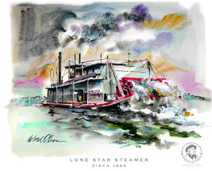
The Lone Star on the Mississippi River
Thank you for helping Save Our Steamer!
You may also print this form, detach this section, and return to:
The Buffalo Bill
Museum
PO Box 284, LeClaire, IA 52753
Phone: 563-289-5580
Your Name: _________________________________________
Address: _________________________________________
Please make checks payable to Buffalo Bill Museum
(**Donations are tax deductible)
Lone Star Steamer was built in 1869 at Lyons, Iowa for Captain Sam Mitchell*. He ran the Davenport to Buffalo, Iowa trade. The boat was not very fast, had limited accommodations, and was withdrawn at the end of the second season. In November 1876 Captain Mitchell sold her to Goss & Company, Sand Dealers in Davenport. They made a towboat of her. It originally was built as a wooden hull, wood burning, side-wheeler; worked as a barge pushing logs down the river. It was 28 tons; 68.4x19.3x3.2.
In 1899-1900 it was remodeled at Kalke Boat Yard in Rock Island, IL at which time she was probably changed to a coal fired steamer and it was probably then that the high-pressure tubular boilers were added. The "Texas" upper deck and four cabins of the crew were added in 1922. Twin tubular boilers, condensing engine 5 ft stroke, mud drum, steam powered wench and steam powered dredging equipment. Somewhere along the line the addition of "Monkey Rudders" were placed behind the paddle wheel, which was a great improvement when backing the boat.
The Lone Star has two sets of small rudders, one-wheel operated and one foot operated. One is steel and one is wood. The boat ran with a four man working crew - Captain, engineer, fireman, and one deckhand. It carried eight people aboard for a total crew, four working and four sleeping. The Lone Star did have a woman cook; she was usually the Captain's wife.
It was last used as
a sand dredge working boat. It had an usually long river life of 99 years,
most wood hull boats had a life of around 35 years, then they usually
catch on fire from sparks. Its last run on the Mississippi was November
1967. It has been dry docked in LeClaire since 1968. Nowadays the tugs
are steel hulls and oil burning.
*Way's Packet Directory 1848-1983
www.buffalobillmuseumleclaire.com